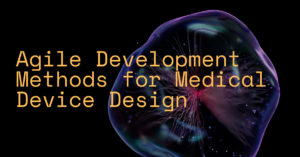
The medical device industry is a highly regulated field, with strict safety and quality standards that must be met. This can make product development a complex and challenging process, particularly when it comes to designing and developing new medical hardware.
One approach that has been gaining popularity in recent years is the use of agile development practices.
Agile development offers a number of benefits that make it well-suited for the medical device industry, including the ability to adapt to change and a focus on collaboration and communication.
Benefits of Agile for Medical Device Design
Agile development is particularly well-suited for the medical device industry because it allows teams to adapt to change. Medical device projects often involve a high degree of uncertainty, with requirements and specifications changing as the project progresses.
Agile allows teams to quickly respond to these changes and make adjustments as needed, which can help to keep the project on track and avoid costly delays.
Another key benefit of agile is the focus on collaboration and communication.
Agile development encourages cross-functional teams to work together closely, with regular check-ins and feedback loops to ensure that everyone is on the same page.
This can help to break down silos and improve communication between different departments and stakeholders, which is critical in the medical device industry where projects can involve multiple partners and suppliers.
Agile Software Development for Medical Devices
Software development plays a critical role in medical device product development, with many devices relying on sophisticated software to control and monitor various functions.
Agile software development methodologies, such as Scrum, provide a framework for managing the software development process and delivering software incrementally.
This allows teams to get feedback and make adjustments early on in the process, rather than waiting until the end of the project to discover that the software doesn’t meet the needs of the stakeholders.
Integrating Hardware and Software Development
One of the biggest challenges in the medical device industry is the need to integrate hardware and software development.
Agile development practices can help to bridge this gap by promoting collaboration and communication between hardware and software teams.
This can be achieved by using tools such as Kanban boards and sprint planning to ensure that both hardware and software development are aligned and progressing in parallel.
The Development Cycle
In an agile development process, the development cycle is broken down into smaller chunks, known as iterations or sprints. Each sprint is typically 2-4 weeks long and includes a planning phase, an execution phase, and a review phase.
During the planning phase, the team will identify the tasks that need to be completed during the sprint. During the execution phase, the team will work on completing those tasks.
During the review phase, the team will review the work that was completed and identify any areas for improvement.
Project Management
Agile development practices rely heavily on project management to keep the team organized and on track. This typically involves using tools such Valispace, Trello or Jira to create and manage tasks, track progress, and identify any issues that need to be addressed.
Project management is a critical component of agile development practices, and it’s particularly important in the medical device industry where the stakes are high and the regulatory requirements are stringent.
Another important aspect of agile development practices for medical hardware design is prototyping. Rapid prototyping allows teams to quickly iterate and test different design concepts, which can help to identify and resolve any issues early on in the process.
This can save time and resources in the long run and can help to ensure that the final product meets the needs of the stakeholders and regulatory requirements.
In addition, agile development practices also incorporate testing and validation at different stages of the development process to ensure that the final product is safe and effective.
This can include testing for usability, reliability, and safety, as well as conducting clinical trials to validate the effectiveness of the medical device.
Valispace for Agile Development of Medical Devices
Valispace is a powerful tool that can be used to support agile development practices for medical hardware design.
The platform allows teams to link real-time requirements and the system model, which can help to ensure that the development process is aligned with the needs of the stakeholders and regulatory requirements.
Additionally, Valispace’s collaboration features enable cross-functional teams to work together efficiently, which can help to improve communication and reduce delays.
If you’re interested in using Valispace for your medical device development project, you can book a call to assess suitability and discuss any bespoke needs with our team.

